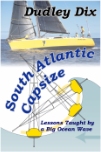|

"South Atlantic Capsize" Paperback US$25
Buy Now
|
Back to Books
HOME
|
Review by Richard Crockett, Editor of Sailing for Southern Africa magazine.
One of the perks of my job is that I do get to read some really good books. Two I have recently read got into that ‘must read’ category.
The first is entitled ‘South Atlantic Capsize’ – Lessons Taught by a Big Ocean Wave.
It is written by Dudley Dix and tells the story of ‘Black Cat’, the crew, the 2014 Cape to Rio Race and the storm that struck the fleet in the opening days of that race. It’s a personal account of what happened on the boat when it was capsized, what damage was done, what the men onboard did to safeguard vessel and crew, what they did to get themselves back to port – as well as what else was going on around them.
It’s rivetting reading as it is not just well written, but written by a man with a serious understanding of the sea, yacht design, yacht construction – and ultimately what happened to them out there.
I like the fact that it gives some history of the Cape to Rio Race, a pretty detailed account of the boat’s design and construction and his careful selection of crew. To many crew selection is simply a case of asking mates, but for Dix it’s far more than that.
So, for anyone contemplating competing in the 2017 Cape to Rio race, this book should be read, not for the scarey stuff, but for the practical preparation tips, and advice on handling bad weather. For those simply making passages at sea, there is lots to learn too.
Review by Andrew Haliburton, experienced offshore yachtman, Portland Oregon. He has personal capsize experience from the deadly Vasco da Gama Race of 1984 off the South African coast.
South Atlantic Capsize - Lessons Taught by a Big Ocean Wave (2015) by veteran sailor and yacht designer Dudley Dix is his first-hand account, and subsequent analysis, of a capsize in the 2015 Cape-to-Rio Race aboard 38-foot sloop Black Cat.
It begins with an interesting history of the Cape-to-Rio Race, and Dudley’s and the boat’s long association with this race through concept, construction and adaptation to rating rule changes. Tension builds through the sections on hurried preparations and the lead-up to a nasty storm. A gripping account follows of the accident sequence that results in this violent wave-induced knock-down and the subsequent recovery. To be clear, this “capsize” was not a roll-over, which would have had even worse consequences. One chapter turns it over to the words of other crew members for their respective experiences from other crew positions.
The objective analysis which follows is rare, and of great value to sailors in the form of lessons learned from the perspective of a yacht designer. The remainder of the book is devoted to a full and fascinating account of the capsize of Swan 64 ketch Sayula II in the 1973 Whitbread Round the World Race and to sections discussing yacht stability and measures that can be taken to be better prepared for a similar situation.
I was consumed by this well written book, eager to compare and contrast Dix’s experiences to those of our own aboard L26 Element in the deadly Force 12 storm that struck the 1984 Vasco da Gama Ocean Race.
My three main takeaways: First, it’s a lesson on the importance of adequate design and boat preparation; if their rudder had not snapped off at the waterline, this capsize would probably not have occurred and Black Cat would have gone on to a great finish. Second, it’s a glimpse of the damage, injury and disarray that can be sustained from an abrupt knockdown topped with a dousing of salt water. Third, my epiphany moment was the lesson learned about motoring without a rudder; for more on that, you’ll have to read the book! Recommended. Offshore sailors, buy a copy and read this book!
|
MENU
Home
Overview
Email
Designs
Materials
Articles
Testimonials
PRICES & ORDERS
LINKS
Boat Sites
Communities
General
|
